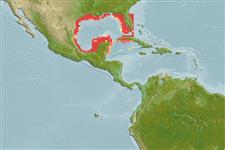Classification / Names
Common names from other countries
Main reference
Size / Weight / Age
Max length : 63.5 cm TL male/unsexed; (Ref. 40637); common length : 35.0 cm TL male/unsexed; (Ref. 3702); max. published weight: 2.8 kg (Ref. 40637); max. reported age: 5 years (Ref. 58079)
Environment
Marine; brackish; demersal
Climate / Range
Subtropical, preferred ?; 30°N - 18°N, 98°W - 80°W
Distribution
Short description
Dorsal
spines
(total): 9 - 11;
Dorsal
soft rays
(total): 25-29;
Anal
spines: 2;
Anal
soft rays: 10 - 12. Colour uniform silvery grey above, without conspicuous spots, silvery below. Pelvic and anal fins pale to yellowish. A faint dark area at bases and axial of pectoral fins. Inside opercle darkish, often visible externally. Mouth large, oblique, lower jaw slightly projecting. Upper jaw with a pair of large canine-like teeth at tip. Lower jaw with a row of widely spaced larger inner-row teeth, gradually increasing in size posteriorly. Chin without barbel or pore, snout with 2 marginal pores. Gas bladder with a pair of horn-like anterior appendages. Soft portion of dorsal fin with few small scales rows at base between soft fin rays (Ref 51721).
IUCN Red List Status (Ref. 115185)
Threat to humans
Harmless
Human uses
Fisheries: commercial
More information
Common namesSynonymsMetabolismPredatorsEcotoxicologyReproductionMaturitySpawningFecundityEggsEgg development
ReferencesAquacultureAquaculture profileStrainsGeneticsAllele frequenciesHeritabilityDiseasesProcessingMass conversion
Tools
Special reports
Download XML
Internet sources
Estimates of some properties based on models
Phylogenetic diversity index
PD50 = 0.5000 many relatives (e.g. carps) 0.5 - 2.0 few relatives (e.g. lungfishes)
Trophic Level
4.2 ±0.3 se; Based on diet studies.
Resilience
Medium, minimum population doubling time 1.4 - 4.4 years (Preliminary K or Fecundity.)
Vulnerability
Moderate vulnerability (36 of 100)
Price category
